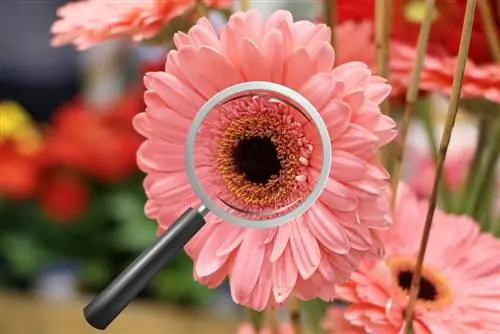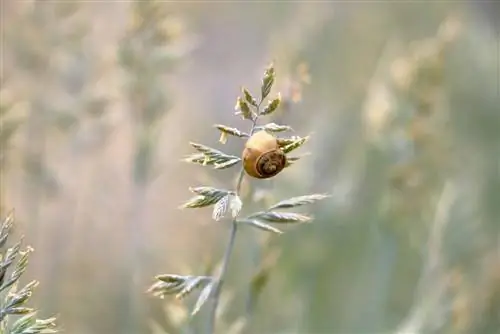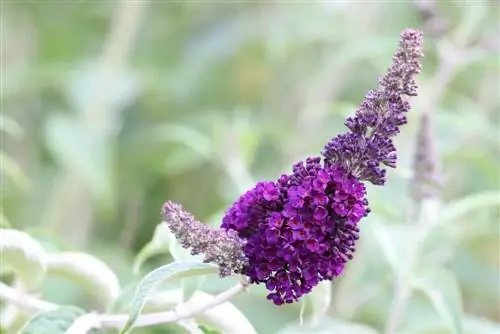- Author admin [email protected].
- Public 2023-12-17 03:39.
- Last modified 2025-01-24 12:45.
Identifying and recognizing shrubs is a skill that every hobby gardener can acquire. In order to reliably identify a species, various plant characteristics and conditions at the place of growth must be examined. At the beginning, the amount of information is confusing. But with a little practice you will quickly see the first successes and determining becomes easier every time.
Before destiny
If you want to identify garden shrubs, most identification keys are not sufficient. It's not just native species that are planted in the garden. Many ornamental shrubs come from other countries and climatic regions, which makes identification difficult. Approach this area slowly and try to identify native shrubs first. If you master the basic identification skills and recognize basic shapes of leaves and flowers, you will find it easier to identify exotic plants. Don't give up too quickly, because the many relevant characteristics can cause confusion, especially at the beginning. Create a notebook and get an initial idea of these aspects:
- Location: Does the shrub grow in the forest, along bodies of water or in meadows?
- Flowers: Does the tree develop an inflorescence or individual flowers?
- Flowering time: Does the shrub bloom in spring, summer or autumn?
- Fruits: If available, what do they look like?
- Leaves: What shape does the foliage have and how are the leaves arranged on the branch?
- Branches: Is the bark smooth or structured?
- Buds: What shape do they have and how do they grow on the branch?
Tip:
Also notice characteristics such asGrowth heightandGrowth habit and pay attention to structures such as thorns or spines.
Classify leaf position
Notice how the leaves sit on the branch. This so-called leaf position is a crucial characteristic and usually represents the first classification of the species. Basically, woody plants are divided into two main groups. Their leaves are opposite or whorled when at least two leaves are opposite each other at the same height on the branch. This group includes grape elderberry and common lilac. The second main group consists of species whose leaves are alternate or tufted. In species such as raspberries, potato roses and blackthorn, the leaves emerge at different heights.
Identify leaf shape
There are numerous leaf shapes that mix with each other and form intermediate shapes. Try to recognize a rough shape in the leaf so that you can initially narrow it down or exclude species. Make notes about whether the leaf surface appears simple or is cut into several partial leaves. In botany, these partial leaves represent the leaflets. If the leaves are not completely cut, botanists speak of fingered or bookended leaves. The following leaf shapes are typical for simply designed leaves:
- ovoid to elliptical: Bird cherry, common spindle bush, red honeysuckle
- round to heart-shaped: Summer and winter lime, common hazel
- oblong to lanceolate: sea buckthorn, willow
- fingered or booked: Viburnum, Hawthorn, Grapevine
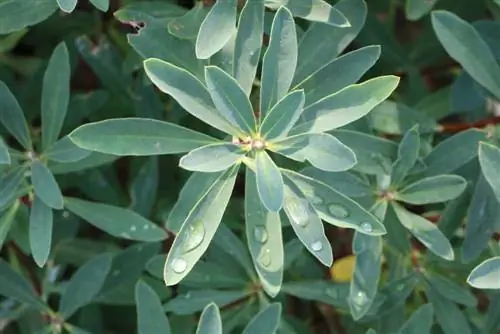
The completely pinnate leaves are a botanical peculiarity, because the supposedly numerous leaves are only one leaf. The number of leaflets varies depending on the species. Leaves that have a terminal leaflet at the tip are called imparipinnate. This includes most bushes and shrubs such as elderberry or vinegar tree. Paired leaves are symmetrically structured and do not develop any leaflets at the end.
Note:
If you notice tiny leaves at the base of the stem, don't be misled. This leaf is not pinnate but has stipules.
Note special leaf characteristics
Not only the shape is a relevant defining characteristic, but also the hair, leaf edge and veins are developed in a species-specific manner. The edge of the leaf can have very different shapes. In most shrubs this is completely inconspicuous and appears smooth, which is why many species are difficult to separate from one another. The range of species narrows as soon as the foliage is bookended, toothed or sawn. Some plants pursue special survival strategies and protect themselves from predators with conspicuous structures. Other leaf shapes are an adaptation to certain living conditions. Take a close look at the sheet and pay attention to clearly visible features:
- striking leaf veins: Dogwood and cornelian with upwardly curved side veins
- spiny leaf edge: European holly develops leaves with sharp spines
- sawn to toothed leaf edge: whitebeam, bird cherry
- downy leaves: Wooly viburnum, white willow
Identifying flowers
When the garden shrubs are in bloom, identification is easy even for beginners. Here too, try to assign the flower to a specific basic shape. Each flower shape is typical of a specific family, which is why you can narrow down the possible species at a glance. Not all plant families contain species that grow like bushes. Lip-shaped, star-shaped or bell-shaped flowers are typical among the shrubs:
- ray or star-shaped: Single hawthorn, common daphne, common buckthorn
- mirror symmetrical: True honeysuckle, red honeysuckle
- bell-shaped to pitcher-shaped: Common cotoneaster, gooseberry, buckthorn
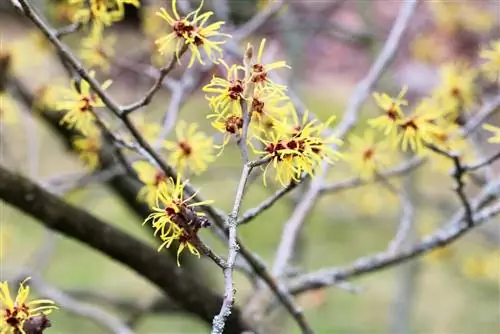
In some trees, numerous inconspicuous individual flowers are crowded together in dense inflorescences, making the shape of the individual flowers difficult to recognize. Birch and willow trees are examples of unusual flower shapes. They develop inflorescences called catkins. These plants do not value attractive petals because they are pollinated by wind or insects.
Tip:
Use all your senses to identify, because smell and feel also provide information about the respective species.
Classifying fruits
There are different approaches to categorize fruits. The simplest variant is a rough division according to the juice content. In contrast to nuts, berries and apples are very juicy. Some species do not develop nutrient-rich or juicy nutrient tissue, but instead send their seeds traveling with a simple protective covering. There are a whole range of different fruit types among these special shapes:
- hairy fruits: Common clematis
- Nuts wrapped in overgrown leaves: Hornbeam
- Cone-like fruits: Gagelstrauch
- woody capsules: Common lilac
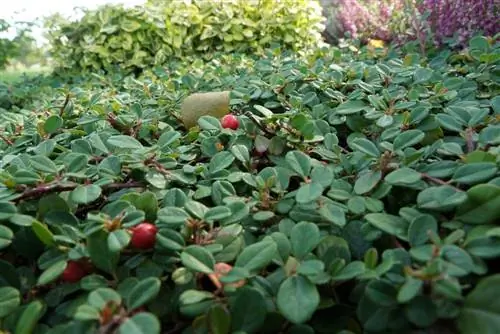
Look at the size of juicy fruits and nuts and determine whether they grow singly or clustered on a stem. These features often allow conclusions to be drawn about the original flower shape, so you can recognize bushes even without flowers. Berries can also be divided into color categories. A reliable identification using standard keys is only possible if the fruits are ripe. They go through different stages of maturity, during which they can change color several times.
Winter determination: branches and buds
If you want to identify ornamental shrubs and bushes in winter, you must first look at the shrub as a whole. Growth habit and branching are important defining characteristics. Also note the height of the plants, because the species have adapted their growth habit to different areas of life. Since these characteristics are not yet sufficient for a reliable species identification, you should use additional characteristics. You can look at the bark on the branches. Since the structure and color of the branches varies depending on age, these aspects provide additional information. It is more important that you take a close look at the buds. These can be designed differently:
- Basic shape: narrow, ovoid to elongated, roundish, conical
- Color: light brown to whitish, dark brown to black, red to reddish brown, greenish
- End: pointed or rounded
- Position: alternate or opposite
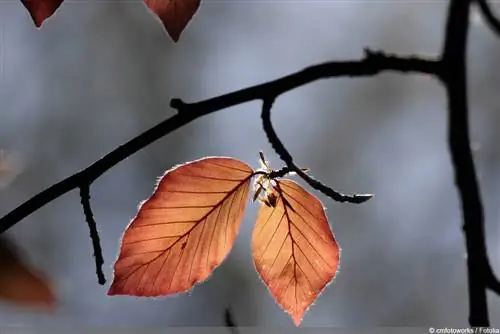
Since determining based on the buds is not easy, we recommend approaching slowly. Identify ornamental shrubs in summer by their flowers and leaves. Then keep an eye on the identified trees and observe the changes. In winter, also look for old leaves and fruits on the ground, as this will help you clearly recognize the trees.
Procedure for coniferous bushes
Conifers have developed completely different structures. Its leaves are greatly reduced and appear in the form of sharp needles. The flowers do not have conspicuous petals because they are wind-pollinated. The fruits also differ from those of hardwoods, as they are usually cone-shaped and occasionally berry-shaped. Nevertheless, the procedure for determining is similar. Most species can be clearly identified based on their needles. If leaf features aren't enough, focus on flowers and fruits.


